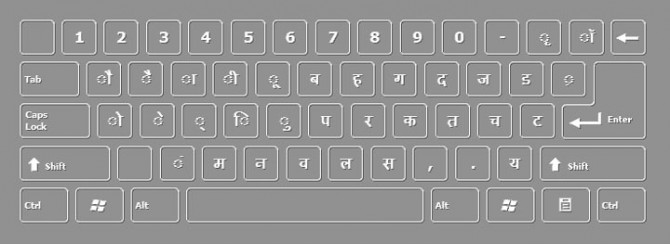HINDI DESKTOP KEYBOARD FREE DOWNLOAD
Type: Virtual Onscreen Keyboard
Platform:
Windows XP
Windows 7
Windows 8 (coming soon)
Windows 10 (coming soon)
The layout of the various characters on a keyboard has profound impact on the efficiency of a typist. If frequently occurring characters are not easily accessible, the rate of typing will go down. An ill-designed keyboard might place a disproportionately high load on the weaker fingers of the hand, leading to typing fatigue (even musculoskeletal injuries in the long term). Hence it is important while designing a keyboard that a significant amount to thought be devoted to determine the most optimal arrangement of characters.
For English and other European language keyboards, considerable investigation has gone into finding a suitable arrangement of characters. The standard keyboard is the QWERTY keyboard that everyone is familiar with. Also there is the Dvorak keyboard which was proposed in the 1920’s and 30’s by August Dvorak and William Dealey. This keyboard was a result of significant ergonomic research and is known to outperform the standard QWERTY keyboard on many factors (home row usage, for example).
Standard keyboard arrangements exist for Hindi too. However, a detailed analysis of whether these are truly opti-
Hindi, the third most commonly spoken language in the world after Chinese and English, is used by more than 600 million people in India.
• To analyze the optimality of the current standard Hindi keyboard with respect to various arrangements possible.
• To find (if it exists) a keyboard arrangement that is better than the current Hindi keyboard in terms of typing convenience and efficiency.
A Summary of Related Research
Research has been done previously in the area of optimizing keyboard layouts using optimization techniques like Genetic Algorithms [6, 2], Simulated Annealing, Ant Colony Optimization etc. Most of this research has been in two broad directions:
• Normal Keyboards - These are traditional keyboards where each character is mapped to a unique key on the keyboard. The objective of optimization in such a case is to arrange the characters on the keys in a manner that is most efficient in terms of typing time and effort. Most of the work done in this regard has been for the Roman script. This work is an effort to extend these same methods to the Hindi language. For further references related to this, refer to [5,7].
• Ambiguous Keyboards - With the emergence of devices like mobile phones, ambiguous keyboards are gaining in popularity and relevance. These are keyboards where multiple characters are mapped to a single key. In such keyboards, either the user presses a key multiple times to enter a character or an ambiguity resolution mechanism predicts which character the user actually intended to type. Some approaches discussed in [4, 3] assume that the system uses a statistical model (derived from commonly used English words) to predict the most likely character that the user wanted to type depending on the characters already entered. Others wait for the user to enter the entire word and then search in a dictionary for all words
which can be formed by the key combinations that the user pressed. In both these approaches, the essential problem is that of ambiguity reduction. So the objective of the optimization in these problems is to determine how to map different sets of characters to the keys so that the resulting ambiguity is minimized. In this paper, we focus on normal keyboards and henceforth, unless stated otherwise, a keyboard should be taken to mean a normal keyboard.
The Devanagari Script
Devanagari is the script in which Hindi is written. The Bureau of Indian Standards has standardized the character set for the Devanagari script. The standard is named the Indian Script Code for Information Interchange (ISCII). The original document issued by the Govt, of India giving detailed specification of the standard can be obtained from [1]. The character set is shown in Figure 1. Note that the script possess some conceptual differences from the Roman script. Some of these are summarized below:
• The concept of тл/га.у(character modifiers) has no parallels in the Roman script. These can occur as stand alone characters or be appended to other characters to modify their sound. There are twelve such matras in all.
• Each character has a shiro rekha (a horizontal line) on top of it.
• Character modifiers, basically matras and other special characters, can occur before, on top, below or after the main character that they modify.
When the same hand is used for two consecutive hits, large distances which require awkward hand posture lead to slow and laborious typing. This happens for diagraphs whose component keys have a vertical distance greater or equal to one. The relevant set Ei is therefore the set of digraphs which are typed using the same hand, but not the same finger and the vertical distance between the two keys is greater
Frontype is easy to use multilingual user-friendly virtual onscreen keyboard that turns any keyboard to your language layout. Just add needed language as input and start to type!
Write a review about HINDI DESKTOP KEYBOARD FREE DOWNLOAD
Your Name:Your Review: Note: HTML is not translated!
Rating: Bad Good
Enter the code in the box below:






















